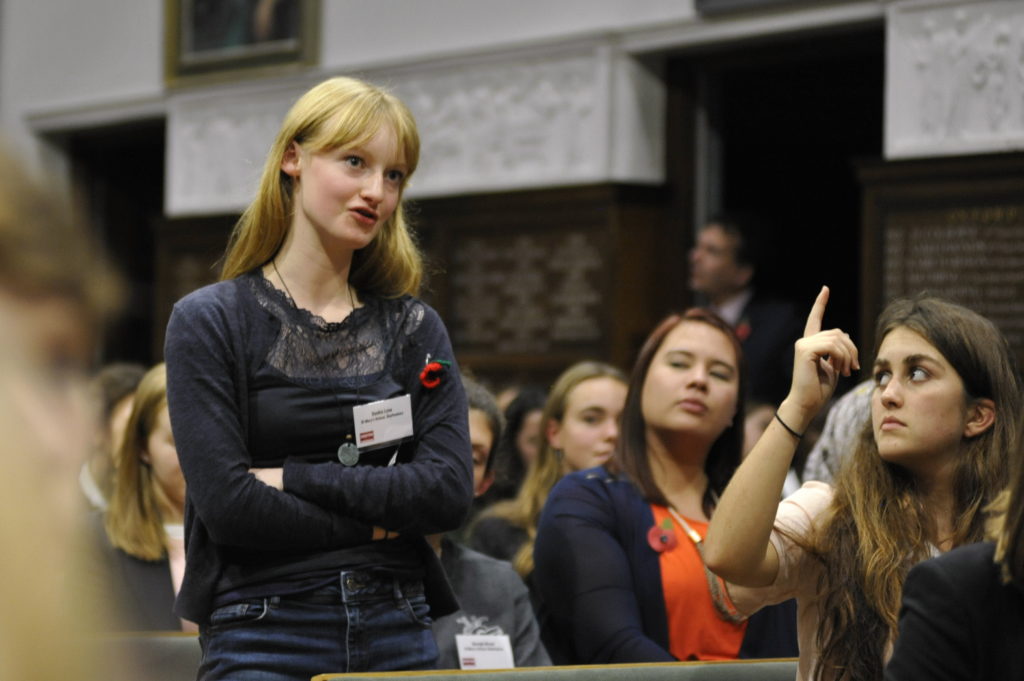The notes below will lead you through the format of the debate and provide some suggestions about what we are trying to achieve in each section and how to go about doing this. We are not trying to be prescriptive about chairing, but are instead suggesting what components, on the chairing front, make for the best debate. As we all know from experience, it is always best when individual personalities are able to shine through too! Remember that as a chair you should be firm, but friendly. You of course want to make people feel at ease but you shouldn’t forget that you are the ringmaster!

Introductions by the Chairperson minutes 0-5
- Introduce yourself.
- Introduce the judges by reading out the biographies provided. Sometimes you will find huge biographies for judges, so make sure you read the biographies BEFORE the debate and edit down if necessary.
- Introduce the students by reading out the biographies the schools should have handed you on arrival, starting with the team FOR the motion.
- Finally, remind the students to be bold in their approach to the debate – trying to bypass the difficult questions won’t wash with the judges! Wish everyone luck!
Students’ opening presentations minutes 5-20
- The debate should then begin! Remind the teams that they each have three minutes to make their opening speech, and that you will tap on the table after two and a half minutes to indicate they have 30 seconds left.
- You should invite the first student speaking FOR the motion (Team A) to begin, then the first student AGAINST (Team B) followed by the second student speaking FOR the motion (Team A) and finally the second student AGAINST (Team B).

Judges’ Questions minutes 20-35
This is a fifteen minute slot with 7.5 mins roughly for each side
- After the formal speeches have finished, you must collect questions from judges for the team speaking FOR the motion. Ask for questions from each judge directly and make a note of the question. WHERE POSSIBLE START WITH THE EXPERIENCED JUDGE ON THE PANEL. Make sure that all three questions are taken before asking the students to respond. It is imperative that all three judges ask a question. Once the students begin to respond try to facilitate a discussion between the judges and the students by encouraging the judges to jump in and push them on their responses.
- In general it is important that chairs are prepared to be assertive with the judges about being concise and straightforward in their questioning. If you do find that a judge is being particularly long-winded or going off topic, encourage them to phrase the question in a simpler way. The aim for this section of the debate is to strike an even balance between getting some strong responses from students and robust questioning from judges.
- The same process must then be repeated for the team speaking AGAINST the motion.
Audience Questions and team cross-examination minutes 35-50
- This section of the debate sees students, teachers and audience members contribute. In this part of the debate we are trying to encourage the atmosphere of a vibrant public meeting.
- As chair, you must take the lead in all of this by announcing that now is the time for the audience questions and that you will be going out to the floor and collecting 4-5 questions for the speakers, before returning to the students to respond. Make sure there is an even balance of questions for the two teams. It is always helpful to keep a note of the number of questions being asked of the teams; if there seem to be far more questions for one team, encourage the audience to ask questions or make points to the other side.
- Once these questions have been collected from the floor, move along the panel giving each student a chance to respond to the questions they would like to – DON’T LET THEM DO MINI SPEECHES, but do allow them to give a reasonable reply. Again, encourage students to be brave enough to answer the tough questions.
- This period of time can also be used by the two teams to directly challenge and rebut the other teams arguments, and replaces the old ‘Team Cross-Examination’ section, so encourage them to put each other under pressure.
- You should then go out for another round of questions (3-4 if possible). If there is time, get a quick response from the speakers and then move them on to summary speeches. If not, you will need to explain to the students that they will now have the hard task of summing up and addressing any questions in just one minute.

Final Remarks minutes 50-55
- You should again lead this part of the debate, and invite each speaker to make their points in the order in which they began – first speaker Team A, first speaker Team B, second speaker Team A, second speaker Team B.
- This finishes the formal speeches
Feedback and comments from the Judges minutes 55-65
- You must now get feedback from each of the judges for Team A. Again it is IMPORTANT that you get feedback from all three judges. This is not an opportunity for judges to tell everyone what they think about this particular issue, but rather the chance to offer an objective take on how students have handled the motion. Aim for 5 minutes feedback per team.
- Say a big THANK YOU for some excellent judging from the panel.

Audience vote and the Judges’ decision minutes 65-70
- Judges should then be asked to leave the room to decide who’s won.
- Once the judges are out of the room, the chair should hold a ‘just for fun’ audience vote.
- If the judges are taking a very long time to reach their decision and you are short on time, do find them and politely remind them that you need a decision.
- Once the judges return, you should invite one of them to explain how they made their decision, and ultimately who won the debate.

